A Tale of Two Capitals
Thursday 26 August 1999 Ė Thursday 2 September
1999
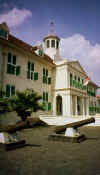 Itís amazing how time flies when youíre having fun.
Three weeks back home in Connecticut relishing the on-going novelty of
hot running water 24 hours a day, clean clothes and good old home-cooked food
(not to mention the hours we spent figuring out how to design and install a home-made website!) seemed to disappear in the blink of an eye.
But we were happy to be off again, complete with a six-month supply of
malaria pills and copious bottles of insect repellent.
Itís amazing how time flies when youíre having fun.
Three weeks back home in Connecticut relishing the on-going novelty of
hot running water 24 hours a day, clean clothes and good old home-cooked food
(not to mention the hours we spent figuring out how to design and install a home-made website!) seemed to disappear in the blink of an eye.
But we were happy to be off again, complete with a six-month supply of
malaria pills and copious bottles of insect repellent.
Our
visit to Indonesia began on the island of Java, in the political capital,
Jakarta. Although we had no fixed plan
as to what our next port of call would be, Ericís first priority was true to
form. And after the bookshops, we headed out
to explore the remaining sights and sounds of Jakarta.
The old town of Batavia has supposedly the
oldest and finest remnant of the Dutch presence in Indonesia, but other than the
old bell-towered town hall overlooking the central square and a small 17th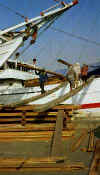 century drawbridge fondly called the Chicken Market Bridge, there was little to
see. The old port of Sunda Kelapa
was intriguing, however. We beat
the tour buses to it and had the entire port to ourselves for over half an hour,
allowing us to take in at leisure the amazing sight of over a hundred moored
Macassar schooners, with workers scurrying about unloading their cargo of cement and
timber brought in from the outer islands. Those
of us with modest athletic abilities (e.g. the two of us) were readily impressed
by the way these men manage to balance such massive timber beams on their heads
whilst walking up precarious gang-planks.
century drawbridge fondly called the Chicken Market Bridge, there was little to
see. The old port of Sunda Kelapa
was intriguing, however. We beat
the tour buses to it and had the entire port to ourselves for over half an hour,
allowing us to take in at leisure the amazing sight of over a hundred moored
Macassar schooners, with workers scurrying about unloading their cargo of cement and
timber brought in from the outer islands. Those
of us with modest athletic abilities (e.g. the two of us) were readily impressed
by the way these men manage to balance such massive timber beams on their heads
whilst walking up precarious gang-planks.
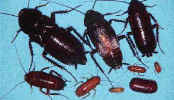 In two days, we had exhausted
the sights of Jakarta (or at least our interest in them) and were off to
Indonesia's cultural capital, Yogyakarta.
Now
becoming more conscious of our budget, we decided to opt for the cheap travel
option to get there: an overnight minibus from Jakarta.
This was no luxury air-conditioned bus, and while we hadnít reckoned on
reclining seats and toilet facilities, we also hadnít expected to spend the
night with a multitude of cockroaches who were out on night patrol and keen to
explore everything the interior of the minibus had to offer Ė including the
passengers. Well, we should be
thankful for small mercies; at least we were able to find a Pizza Hut for
lunch that day.
In two days, we had exhausted
the sights of Jakarta (or at least our interest in them) and were off to
Indonesia's cultural capital, Yogyakarta.
Now
becoming more conscious of our budget, we decided to opt for the cheap travel
option to get there: an overnight minibus from Jakarta.
This was no luxury air-conditioned bus, and while we hadnít reckoned on
reclining seats and toilet facilities, we also hadnít expected to spend the
night with a multitude of cockroaches who were out on night patrol and keen to
explore everything the interior of the minibus had to offer Ė including the
passengers. Well, we should be
thankful for small mercies; at least we were able to find a Pizza Hut for
lunch that day.
Having endured a thoroughly
unpleasant night, our budget concerns of the previous day went out the window
and upon arriving at our destination, we checked into the best hotel in town.
Troubles in East Timor had just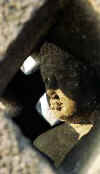 started brewing, and there were
surprisingly few tourists to be seen anywhere.
As a result, we managed to negotiate four-star accommodation and
facilities for the price of two and had the hotel pool and gym pretty much to
ourselves for three glorious days, in between sightseeing.
started brewing, and there were
surprisingly few tourists to be seen anywhere.
As a result, we managed to negotiate four-star accommodation and
facilities for the price of two and had the hotel pool and gym pretty much to
ourselves for three glorious days, in between sightseeing.
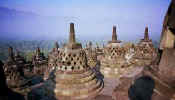 The highlights of
Yoga were two day trips to the historical sites of Borobodur and Prambanan.
Borobodur is considered to be one of the greatest Southeast Asian
Buddhist monuments, rediscovered only in 1814.
Constructed in the early part of the 9th century, the temple
was built up on a hill; six square bases topped by three circular ones housing
in excess of 500 Buddha images, including 72 of which sit on the upper circular
terraces inside latticed stupas. We
had set our alarms early and arrived just as the sun was rising, mercifully well
before the tour buses and touts had arrived on the scene.
The highlights of
Yoga were two day trips to the historical sites of Borobodur and Prambanan.
Borobodur is considered to be one of the greatest Southeast Asian
Buddhist monuments, rediscovered only in 1814.
Constructed in the early part of the 9th century, the temple
was built up on a hill; six square bases topped by three circular ones housing
in excess of 500 Buddha images, including 72 of which sit on the upper circular
terraces inside latticed stupas. We
had set our alarms early and arrived just as the sun was rising, mercifully well
before the tour buses and touts had arrived on the scene.
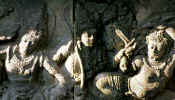
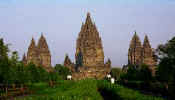 Prambanan is the biggest Hindu
temple complex in Java. Spurred on
by our success at arriving before the crowds
Prambanan is the biggest Hindu
temple complex in Java. Spurred on
by our success at arriving before the crowds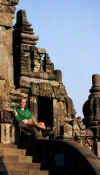 at Borobodur, we once again left
our hotel in the wee hours and arrived before sunrise. Tired and pining for the buffet breakfast back at the hotel,
we were nonetheless rewarded with an entire hour at the complex before anyone
else arrived. Ample time for
unobstructed photo opportunities, not to mention Ericís one great luxury in
life: to sit back, relax and contemplate life over a pipe.
at Borobodur, we once again left
our hotel in the wee hours and arrived before sunrise. Tired and pining for the buffet breakfast back at the hotel,
we were nonetheless rewarded with an entire hour at the complex before anyone
else arrived. Ample time for
unobstructed photo opportunities, not to mention Ericís one great luxury in
life: to sit back, relax and contemplate life over a pipe.
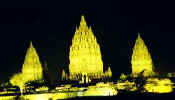 We were to return to Prambanan
again that evening to watch a unique performance of the Ramayana ballet.
With nary a tutu or ballet shoe in sight, this spectacle was a fine
example of a traditional Javanese performing art.
The epic story of the Ramayana is widespread across South
Asia, and considered sacred by Hindus. Originating in India, it tells the story of a
prince named Rama, an incarnation of the Hindu Lord Vishnu, who was born to rid
the earth of the terrible demon Ravana. Exiled
for fourteen years due to his stepmotherís fit of jealousy on the eve of his
coronation, Rama was banished to the forest with his wife Sita and brother
Laksmana. When Sita was abducted by
Ravana, the two brothers set out to rescue her from his isolated
We were to return to Prambanan
again that evening to watch a unique performance of the Ramayana ballet.
With nary a tutu or ballet shoe in sight, this spectacle was a fine
example of a traditional Javanese performing art.
The epic story of the Ramayana is widespread across South
Asia, and considered sacred by Hindus. Originating in India, it tells the story of a
prince named Rama, an incarnation of the Hindu Lord Vishnu, who was born to rid
the earth of the terrible demon Ravana. Exiled
for fourteen years due to his stepmotherís fit of jealousy on the eve of his
coronation, Rama was banished to the forest with his wife Sita and brother
Laksmana. When Sita was abducted by
Ravana, the two brothers set out to rescue her from his isolated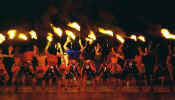 kingdom on the
far side of the southern ocean and on the way, met and befriended a dispossessed
monkey king Sugriva (as you do). At the end of
a bloody war, Ravana was killed and Sita reunited with her husband and together,
they returned to the kingdom of Ayodhya to claim his right to the throne.
It is an intriguing story and watching it unfold against a backdrop of the
illuminated temples of Prambanan, it was truly magical, even if we were only
among a handful of people in the audience!
kingdom on the
far side of the southern ocean and on the way, met and befriended a dispossessed
monkey king Sugriva (as you do). At the end of
a bloody war, Ravana was killed and Sita reunited with her husband and together,
they returned to the kingdom of Ayodhya to claim his right to the throne.
It is an intriguing story and watching it unfold against a backdrop of the
illuminated temples of Prambanan, it was truly magical, even if we were only
among a handful of people in the audience!